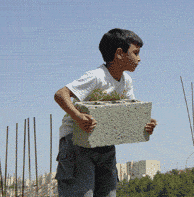24 August 2002

ICADH, 2002
Physicians for Human Rights were going to Bethlehem to bring medical supplies to the needy population there. Ta’ayush, a Jewish/Arab activist group, were going to Nablus to deliver humanitarian supplies and protest the closure and continuing Occupation. The Israeli Committee Against House Demolitions (ICAHD) were going to Anata, East Jerusalem, to continue rebuilding the home of Salim and Arabia Shawamreh which had been demolished three times, and rebuilt twice already by ICAHD. Today’s rebuilding activity was funded and organized as part of the Global Campaign to rebuild Palestinian Homes.
Our minibus was not quite full when we set off for Jerusalem. Many activists were choosing one of the other activities for their Saturday protest. The bus leader in Jerusalem called to say that their bus was also on the way to Anata. About half way to Jerusalem the driver asked if it was OK to take Route 443 via Modi’in instead of Route 1. He was given the go-ahead and took the exit. The Modi’in road saved about fifteen minutes off the trip, but since the Intifada started the numbers of cars on that road had dwindled due to occasional Palestinian sniper attacks.
There had been no attacks for several months and the road was now deemed relatively safe once again. However one of our company had a problem with the decision. Since 1980 he had refused to travel on Israel’s ‘colonial’ roads on principal, and was mildly upset that the group had chosen to take the route. He became a bit mollified when someone pointed out that we were on a political mission and this road was the shortest route.
After passing two military checkpoints, we entered Jerusalem and were soon being greeted by Salim Shawamreh at the building site in Anata. One volunteer brought him some presents, a young potted Eggplant (Aubergene) bearing fruit and some freshly picked hot peppers from his garden. The crew started the day’s work with mixing concrete for the perimeter wall which was being built by the ‘dry stone’ method. Stones and rocks from adjacent hills were laid in courses on top of one another and concrete was poured between the stones and behind them to bind everything together. It was an ideal construction method for unskilled labor. The volunteers formed a chain and passed buckets of concrete from the electro-mechanical mixer to the spot where Salim’s sons were building the wall. Even the Palestinian bus driver joined in the work, despite his pressed trousers and shirt. He had no idea what he was coming to, and was so impressed that he participated along with the other volunteers.
After a couple of hours of hard work the crew took a lunch break and feasted on maklubeh cooked by Salim’s wife Arabia. It is a traditional dish of chicken and vegetables, served on a huge mound of rice. Today, in respect of some volunteers’ diets, there was a vegetarian option, equally delicious. The main course was washed down with chilled water and soft drinks, followed by fruit and traditional Arabic coffee. Then there was a bit of juggling with the children led by Fred Schlomka, ICAHD staffer and resident juggler. The kids had a great time tossing beanbags in the air and learning the rudiments of juggling.
After lunch it was back to work. This time on the planting bed on the downhill side of the house. Salim was planning to replace the dozens of trees that had been destroyed when the house was last demolished. The soil was full of boulders and stones which had to be removed by hand before new topsoil could be added. It was arduous work but the volunteers persevered with good humor and the pile of rocks grew steadily. These would in turn be used as the substrate for a concrete patio around the perimeter of the house.
After noticing a new fence on a nearby hillside, an ICAHD member went to investigate. Salim speculated that perhaps it was part of the notorious ‘fence’, that was to separate the Israeli and Palestinian populations. However after looking at the fence it appeared to have half encircled the hill and perhaps eventually would surround the hill creating an enclosure for a new settlement or industrial area. This area was part of the E1 planning district lying between Jerusalem and Ma’ale Adumim which the government has long vowed to completely fill with Israeli settlements, Industrial zones, shopping malls and tourist facilities. In so doing they would essentially cut the West Bank in half with Israeli sovereign land and forever deny the possibility of a Palestinian State with contiguous territory.
As the work was winding down a pair of Greek journalists showed up and took photographs and interviews with Salim and the workers. Everyone then piled back into the buses to be dropped back off at the pick-up points. Another satisfying day’s work completed. Another day of building relationships with Palestinian friends and colleagues. Another day of constructive resistance to the ongoing Israeli Occupation of Palestinian lands.
The Global Campaign to Rebuild Palestinian Homes is dedicated to raising $1,000,000 by the end of this year and rebuild at least 20 homes throughout the West Bank and Gaza.
Related links: